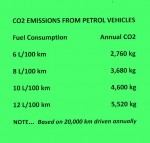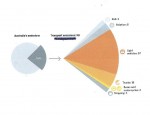AVERAGE CAR EMITS FOUR TONNES OF CO2 YEARLY
Every litre of petrol that is burned produces about 2.4 kg of CO2.
One litre of petrol (that weighs about (0.75 kg) but produces about 2.4 kg of carbon dioxide (CO2) The bottom line: the more fuel you use‚ the more CO2 you produce. If you’re a motorist who drives 20,000 km each year‚ you’re emitting approximately four tonnes of CO2 per year that’s about three times the weight of your car!
Diesel creates about 15% more CO2 per litre. However, many vehicles using diesel fuel achieve higher fuel economy than similar vehicles that use petrol, which generally offsets the higher carbon content of diesel fuel. It’s true that automakers have significantly reduced the CAC
emissions from new vehicles. But one component in exhaust emissions is directly impacted by the type and amount of fuel your vehicle uses – carbon dioxide (CO2). This is the principle greenhouse gas linked to climate change.
The transport sector accounts for 16 per cent of Australia’s greenhouse gas emissions. Light vehicles account for the largest share—10 per cent of Australia’s total emissions.
The transport sector spans four modes—road, rail, aviation and shipping. Greenhouse gas emissions from transport come primarily from fossil fuels combusted in vehicles. Australia’s per capita transport emissions are higher than those of most other countries. This is partly because we use more road transport and partly because our road passenger transport is relatively inefficient
Emissions from generation of electricity used by electric vehicles are accounted for in the electricity sector. Combustion of biofuels produces zero emissions for transport accounting purposes, but biofuel production emissions can be substantial and are included in the agriculture or industry sectors.
Victorian motorists who switch to an electric car can expect to produce less than half the greenhouse gas emissions than they would if driving a petrol-powered car – BUT only if they run it on 100 per cent green power, government research has found. If they don’t they will generate more emissions.
.



4 Comments
It is important to grasp the arbitrary nature of the claims to impending climate disaster, their lack of support among many eminent scientists, the history of failed predictions of disaster (of which this is merely the last), and the lack of viable alternatives to fossil fuels. It is important to recognize that there is no natural “disaster” looming over the horizon—only a political disaster of our own making.
Tim Flannery, the highly waged Climate Council’s co-founder, had warned that because of climate change there would no longer be sufficient rainfall to fill dams and Australian cities would need desalination plants to cater for their water needs, just before the record floods had caused dams to overflow. In a later report, he said “climate change cannot be ruled out” as a cause of the floods. Then, in an apparent contradiction, he predicted that heatwaves, made worse by concrete asphalt and buildings, will cause deaths and violence in western Sydney.
The removal of trees adds more CO2 to the earth’s atmosphere than the total emitted from the world’s cars and trucks. Any realistic plan to reduce global warming sufficiently, if there really is a correlation with increased carbon dioxide, must rely in part on preserving tropical forests. Conservation costs money, while profits from timber, charcoal, pasture and cropland drive people to cut down forests. This also wipes out biodiversity since more than half of the world’s plant and animal species live in tropical rain forests.
.
The data below is interesting since atmospheric levels of CO2, the claimed cause of higher temperatures, would have been a fraction of what they are today which suggests that the higher temperatures during these periods were not related.
In Melbourne on the 20th December 1953 the mercury climbed to a maximum of 42.1 degrees at 1.30 p.m.-the highest December reading since 1898. The highest all-time December reading at that time was 43.7 degrees, In 1876.
Melbourne’s Hottest February on record was in 1898 with an average maximum temperature of 30.2 degrees.
Melbourne’s hottest January on record was in 1951 with an average maximum temperature of 29.7 degrees.